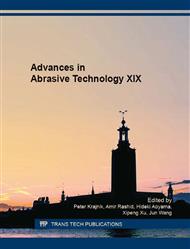[1]
Erich Fitzer. The future of carbon-carbon composites [J]. Carbon, 1987, 25(2): 163-190.
DOI: 10.1016/0008-6223(87)90116-3
Google Scholar
[2]
Sheehan J E, Buesking K W, Sullivan B J. Carbon-Carbon Composites[J]. Annual Review of Materials Research, 2003, 24: 19-44.
Google Scholar
[3]
Li H. The Status and Future on Research and Application about Carbon/ Carbon Composites in the Aeronautical Area[J]. Journal of Materials Engineering, 1997(7): 8-10.
Google Scholar
[4]
GUO Meng FAN Hui tao LI Hui. C/C Composites Processing Technology Research Applied in the Field of Aerospace[J]. Equipment Manufacturing Technology, (2014).
Google Scholar
[5]
Ranga Komanduri. MACHINING OF FIBER-REINFORCED COMPOSITES[J]. Machining Science & Technology, 1997, 1(1): 113-152.
DOI: 10.1080/10940349708945641
Google Scholar
[6]
Hojo M, Yatomi M, Tsuda H, et al. Fracture Mechanism of C/C Composites[C]/ The Jsme Spring Meeting. (1997).
Google Scholar
[7]
Pei ZJ, Khanna N, Ferreira PM (1995) Rotary ultrasonic machining of structural ceramics-a review[C]. Eng Sci Proc 16(1): 259-78.
Google Scholar
[8]
Wang X, Zhou M, Gan G K, et al. Theoretical and Experimental Studies of Ultraprecision Machining of Brittle Materials with Ultrasonic Vibration[J]. International Journal of Advanced Manufacturing Technology, 2002, 20(2): 99-102.
DOI: 10.1007/s001700200130
Google Scholar
[9]
Q. Feng, W. L. Cong, Z. J. Pei, et al. ROTARY ULTRASONIC MACHINING OF CARBON FIBER-REINFORCED POLYMER: FEASIBILITY STUDY[J]. Machining Science & Technology An International Journal, 2012, 16(3): 380-398. 228(4): 504-514.
DOI: 10.1080/10910344.2012.698962
Google Scholar
[10]
Zhang C, Cong W, Feng P, et al. Rotary ultrasonic machining of optical K9 glass using compressed air as coolant: A feasibility study[J]. Proceedings of the Institution of Mechanical Engineers Part B Journal of Engineering Manufacture, (2013).
DOI: 10.1177/0954405413506195
Google Scholar
[11]
Liu J W, Baek D K, Ko T J. Chipping minimization in drilling ceramic materials with rotary ultrasonic machining[J]. International Journal of Advanced Manufacturing Technology, 2014, 72(9-12): 1527-1535.
DOI: 10.1007/s00170-014-5766-y
Google Scholar
[12]
Pei Z J, Prabhakar D, Ferreira P M, et al. A Mechanistic Approach To The Prediction Of Material Removal Rates In Rotary Ultrasonic Machining[J]. Journal of Engineering for Industry, 1994, 64(2): 142-151.
DOI: 10.1115/1.2803288
Google Scholar
[13]
Wang Q, Cong W, Pei Z J, et al. Rotary ultrasonic machining of potassium dihydrogen phosphate (KDP) crystal: An experimental investigation on surface roughness[J]. International Journal of Mechatronics & Manufacturing Systems, 2009, 11(2): 66-73.
DOI: 10.1016/j.jmapro.2009.09.001
Google Scholar
[14]
Li Z C, Jiao Y, Deines T W, et al. Rotary ultrasonic machining of ceramic matrix composites: feasibility study and designed experiments[J]. International Journal of Machine Tools & Manufacture, 2005, 45(12-13): 1402-1411.
DOI: 10.1016/j.ijmachtools.2005.01.034
Google Scholar
[15]
Yuan S, Zhang C, Amin M, et al. Development of a cutting force prediction model based on brittle fracture for carbon fiber reinforced polymers for rotary ultrasonic drilling[J]. International Journal of Advanced Manufacturing Technology, 2015: 1-9.
DOI: 10.1007/s00170-015-7269-x
Google Scholar
[16]
Cong W L, Pei Z J, Feng Q, et al. Rotary ultrasonic machining of CFRP: A comparison with twist drilling[J]. Journal of Reinforced Plastics & Composites, 2012, 31(5): 313-321.
DOI: 10.1177/0731684411427419
Google Scholar
[17]
K. Ding, Y.C. Fu, H.H. Su, Y. Chen, X.Z. Yu, G.Z. Ding, Experimental studies on drilling tool load and machining quality of C/SiC composites in rotary ultrasonic machining, J. Mater. Process. Technol. 214 (12)(2014) 2900-2907.
DOI: 10.1016/j.jmatprotec.2014.06.015
Google Scholar


